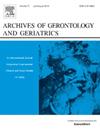Artificial intelligence applications and aging (1995–2024): Trends, challenges, and future directions in frailty research
IF 3.5
3区 医学
Q2 GERIATRICS & GERONTOLOGY
引用次数: 0
Abstract
Background
Frailty, a significant predictor of adverse health outcomes, has become a focal point of research, particularly with the advent of artificial intelligence (AI) technologies. This study aimed to provide a comprehensive bibliometric analysis of research trends in AI and frailty to map conceptual developments, collaborations, and emerging themes in the field.
Methods
A systematic search was conducted using the Scopus database employing a comprehensive set of keywords related to AI and frailty. The search was refined to include only original articles in English, yielding 1213 documents. Data extraction was performed in October 2024 and exported in the CSV and BibTeX formats. Annual growth trends were analyzed using Microsoft Excel, while VOSviewer and R-package were used for bibliometric analyzes and visualization to identify key contributors, collaborations, and thematic clusters.
Results
The analysis revealed rapid growth in research publications, with AI applications in frailty gaining prominence over the past decade. Thematic clusters highlight areas such as predictive modeling, machine learning applications, and geriatric care innovations. The United States, United Kingdom, and Italy emerged as leading contributors to publications and collaborations. The key topics included prediction models, dementia, sarcopenia, and rehabilitation. This bibliometric study underscores the increasing integration of AI into frailty research, revealing key trends, collaborative networks, and emerging areas of focus.
Conclusion
These findings can guide future research, foster collaborations, and enhance the application of AI technologies to improve frailty assessment and management.
人工智能应用与老龄化(1995-2024):脆弱性研究的趋势、挑战和未来方向
虚弱是不良健康结果的重要预测因素,已成为研究的焦点,特别是随着人工智能(AI)技术的出现。本研究旨在对人工智能和脆弱性的研究趋势进行全面的文献计量分析,以绘制该领域的概念发展、合作和新兴主题。方法利用Scopus数据库系统检索人工智能和脆弱性相关的综合关键词。搜索经过改进,只包括英文原创文章,得到1213份文件。数据提取于2024年10月进行,导出为CSV和BibTeX格式。使用Microsoft Excel分析年度增长趋势,使用VOSviewer和R-package进行文献计量分析和可视化,以确定关键贡献者、合作和专题集群。分析显示,研究出版物快速增长,人工智能在衰弱方面的应用在过去十年中日益突出。专题集群突出了预测建模、机器学习应用和老年护理创新等领域。美国、英国和意大利成为出版物和合作的主要贡献者。主要主题包括预测模型、痴呆、肌肉减少症和康复。这项文献计量学研究强调了人工智能与脆弱性研究的日益整合,揭示了关键趋势、协作网络和新兴重点领域。结论这些发现可以指导未来的研究,促进合作,并加强人工智能技术在改善脆弱性评估和管理方面的应用。
本文章由计算机程序翻译,如有差异,请以英文原文为准。
求助全文
约1分钟内获得全文
求助全文
来源期刊
CiteScore
7.30
自引率
5.00%
发文量
198
审稿时长
16 days
期刊介绍:
Archives of Gerontology and Geriatrics provides a medium for the publication of papers from the fields of experimental gerontology and clinical and social geriatrics. The principal aim of the journal is to facilitate the exchange of information between specialists in these three fields of gerontological research. Experimental papers dealing with the basic mechanisms of aging at molecular, cellular, tissue or organ levels will be published.
Clinical papers will be accepted if they provide sufficiently new information or are of fundamental importance for the knowledge of human aging. Purely descriptive clinical papers will be accepted only if the results permit further interpretation. Papers dealing with anti-aging pharmacological preparations in humans are welcome. Papers on the social aspects of geriatrics will be accepted if they are of general interest regarding the epidemiology of aging and the efficiency and working methods of the social organizations for the health care of the elderly.

 求助内容:
求助内容: 应助结果提醒方式:
应助结果提醒方式:


